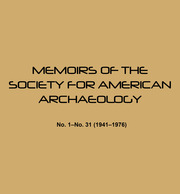No CrossRef data available.
Article contents
The Lascaux Cave
Published online by Cambridge University Press: 27 June 2018
Extract
The Lascaux Cave, one of the most important single sites of upper Palaeolithic art ever discovered, is located near Montignac (Dordogne), 16 miles up the Vézère River from the famous town of Les Eyzies. It was found in September 1940 by two French schoolboys out rabbit hunting. Called the “Versailles of Prehistoric Man,” Lascaux ranks among the world's oldest and most remarkable art galleries. It has been completely sealed off from the outside world since late upper Pleistocene times, and it is now generally believed that the majority of the paintings are upper Perigordian (Gravettian) in date—Phase 2 in the upper Palaeolithic art sequence of western Europe. That they were produced during a time of climatic amelioration, possibly the one known as the Achen retreat, is borne out by the fact that the animals depicted belong much more to a steppe and forest type of fauna, than they do to a colder tundra group. For example, there are no mammoths and no reindeer shown, but there are many horses, a considerable quantity of cattle, bison and several ibexes.
- Type
- Research Article
- Information
- Copyright
- Copyright © Society for American Archaeology 1951
References
* The writer wishes to express his indebtedness to M. l'Abbe H. Breuil, the leading authority on the upper Palaeolithic art of Western Europe, whose interesting and informative letter of July 5, 1950, from Johannesburg has been extensively quoted in this report, as well as to Prof. E. S. Barghoorn for his careful analysis of a sample of charcoal from the Lascaux locality. He is also grateful to Mr. Harper Kelley of the Musee de l'Homme, Paris, and to M. Severin Blanc, Regional Director of Prehistoric Antiquities, Les Eyzies (Dordogne), for their cooperation and help in many ways in connection with the preparation of this paper.
** This discovery was originally reported by M. l'Abbe H. Breuil in a paper read to the Academie des Inscriptions et Belles-Lettres on 11 October 1940. (See also: L'Anthropologie, t. 49, 1940, pp. 779-781 and L'lllustration for 4 January, 1941.) Subsequently it was announced in Germany by Prof. J. M. Santa-Olalla (IPEK, Bd. 15, 1941, pp. 2-12), in the U.S.A. by the late Prof. G. G. MacCurdy (Amer. Jour. Arch., vol. 45, 1941, pp. 509- 512) and in England by the Ill. London News of 28 February, 1942, and by W. H. Riddel (Antiquity, vol. 16, no. 64, 1942, pp. 359-360). For further information concerning this important locality, see: Breuil, (l'Abbe) H. —Bull. Soc. Prehist. Fr., t. 47, no. 6-8 (1950), pp. 355- 363; Broderick, Alan H.—Ill. London News, vol. 210, no. 5634 (1947), pp. 376-379; Ibid.—“Lascaux, A Commentary,” London, 1949; Peyrony, Denis—Bull. Soc. Prehist. Fr., t. 46, no. 3-4 (1949), p. 117; t. 47, no. 3-4 (1950), pp. 135-137; and Windels, F.—“Lascaux: Chapelle Sixtine de la Prehistoire,” Montignac-sur-Vezere, 1948). An English edition of the latter, very profusely illustrated book was published in 1950 under the title “The Lascaux Cave Paintings” by The Viking Press, New York. In addition, two excellent popular accounts have appeared, one in Life Magazine (vol. 22, no. 8, 1947), and the other in The National Geographic Magazine (vol. 94, no. 6, 1948).


